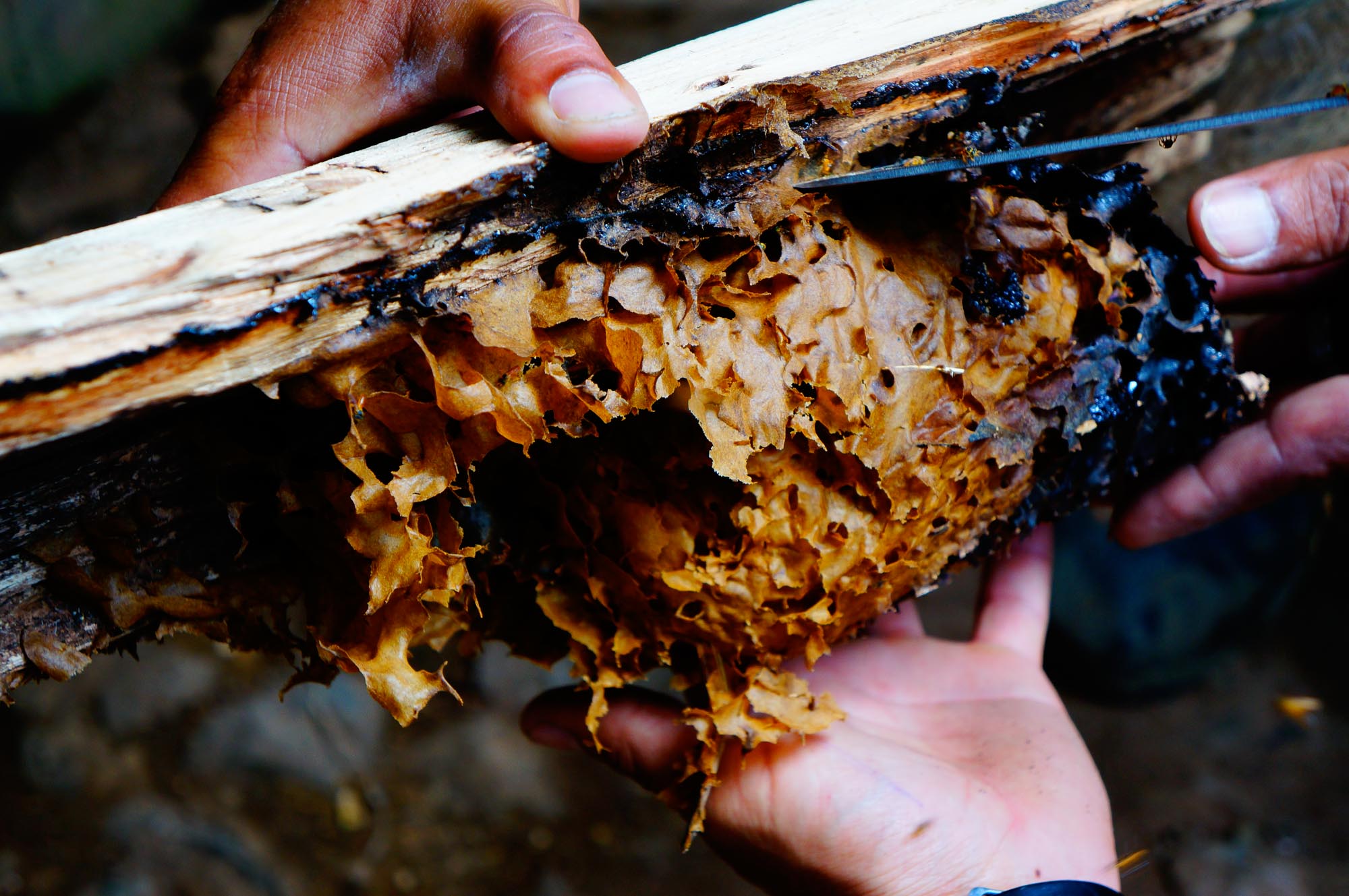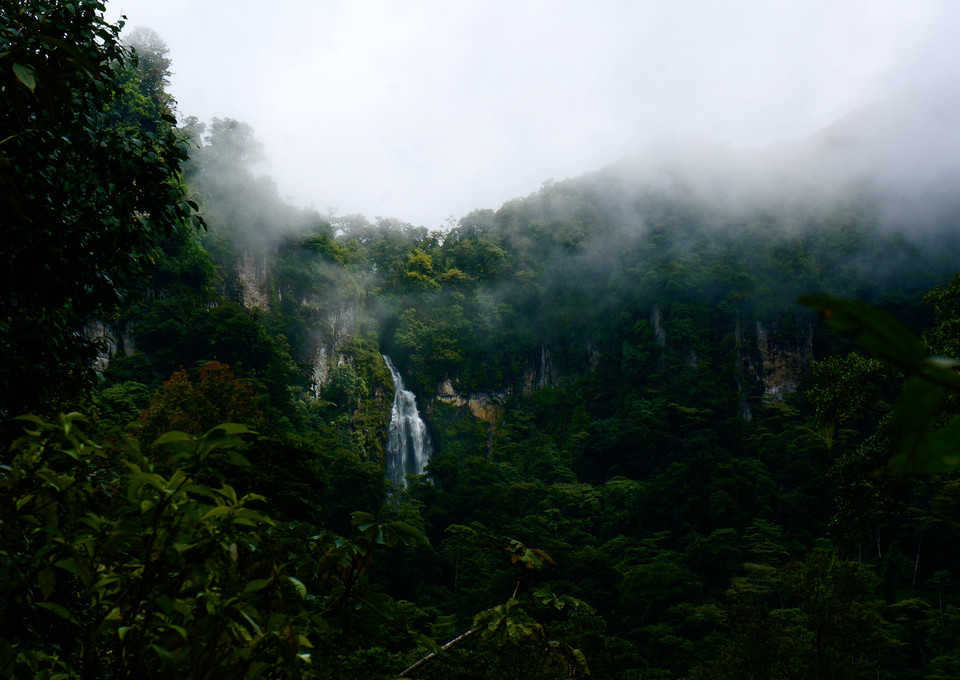Alan Bolt walks ahead, a few steps at a time. He stops regularly, looking up and down, listening and feeling.
“Look at it. Isn’t it beautiful?’ he whispers, caressing the leaves of a bamboo plant, admiring the progress it has made despite the lack of rain in the recent El Nino years.
“It’s growing, and through that, it will change everything!”
He walks on. After a while, he stops again.
“See this? It’s a liquidambar seedling. It will grow to be very big tree and its sap is a natural antibiotic. But we need to help it.” With his machete, Alan carefully chops away branches from trees and plants that are blocking the sunlight and living room this precious seedling needs to prosper. One plant, though, he leaves.
“That is a chilamate,” he says. “It’s a water retaining perennial, and we will need it badly in the times to come!”
Water is everything in this young but thriving secondary forest on the slope of the Macizo de Peñas Blancas massif, in the mid-north of Nicaragua. And Bolt knows this better than most.
Although his name is English – Bolt’s grandfather migrated to Nicaragua some time in the early twentieth century, settling next to an indigenous community in the central northern mountains – Alan was brought up by his indigenous grandmother, a member of the Nahuatl-speaking indigenous people, and strongly identifies himself with his indigenous roots. According to what’s left of the oral tradition passed down to Alan, the Nahuatl trace their origins back to an arid region dotted with caves, where the scarcity of water helped define the character of Nahuatl culture. Water remained an essential theme for some of the Nahuatl groups for millennia to come, even when some of them migrated to more water abundant tropical environments to the south.
The remarkable growth of the forest Alan is taking us through has been catalyzed by human intervention. Some environmental scientists consider it a small wonder. Only sixteen years ago this area was cattle pasture; there were only a handful of trees, and the landscape was dominated by a long and invasive grass cultivated to feed the cattle.
The removal of trees, especially in this tropical ecosystem, can have devastating effects on the local watershed. The streams, left unprotected from the sun, evaporated in the dry season. When it rained, the little flora remaining couldn’t hold the water, which ripped through the landscape, causing flash floods downstream and leaving the soil eroded and poor upstream. And it wasn’t just the land that was affected: without the deep roots of the great trees, the water couldn’t reach and replenish the forest’s underwater reserves, causing many of the springs to disappear.
Twenty years ago, with the situation at crisis point downstream, communities sought the help of Alan Bolt. Together with a Dutch partner, he bought what little he could of the small but important watershed feeding the vast Río Coco river. The watershed separates Nicaragua from Honduras and crosses the BOSAWAS biosphere reserve, one of the largest protected – but still very much endangered – forest areas of Central America.
For sixteen years, Alan worked with the local communities to revegetate and nurture the forest. Eventually, the springs and streams recovered, and even the animals that had fled the clear-cutting and frequent hunting in the area came back. Today, the springs and streams in this fledgling forest are estimated to provide approximately 30,000 people with clean water for drinking and irrigating crops.
To some, buying land in order to take care of a common resource is too extreme to be considered a model solution. The forest is part of a protected area, after all, and there are laws in place to protect it. But in a poor country like Nicaragua, exploiting these areas’ natural resources provides badly needed income for both ordinary people and the government. And for a people living so close to the edge, protecting the country’s wild places can seem like a luxury they can’t afford.
The result, as Alan sees it, is a society driving itself to insane extremes by jeopardizing the very things that make life possible: water and the forests. In Nicaragua and beyond, deforestation, climate change and the overuse of agro-chemicals have resulted in a diminishing amount of fresh water reserves, of which an increasing amount have become contaminated. In the culture in which Alan grew up in, the current situation is simply unimaginable.
“It was very practical,” Alan says of the Nahuatl approach. “We knew our job as a species is to take care of the water and serve all life. Take care of the water, and you are taking care of all life, including your own.”
Existential doubts, Alan says, didn’t exist where he grew up. People never had a reason to question their reason to exist, or that of anything or anyone else. They knew what they had to take care of, and that was that.
Nowadays, he says, it’s more complicated. Planting trees to take care of the water is pretty straightforward. Working with people, though equally necessary, is harder.
To build upon the experiment in the Peñas Blancas massif, and to make full use of his decades of experience with indigenous peoples, rural development and ecosystems across Latin America, Alan and his partners founded ‘Centro de Entendimiento con la Naturaleza’, or CEN, a centre for developing people’s understanding of nature.
CEN’s vital work is to improve the relationship between our species and all the other species we live with and depend on. For the massif project, at the same time as they began reforesting the landscape, CEN started working with the local farming population, who were largely unaware of the consequences of the way they were working the land.
The process with the local farmers was about much more than teaching sustainable farming practices. If people are ever to learn how to take care of anything, they themselves first need to be taken care of, through education and a holistic approach. CEN taught farmers about the hazards of agro-chemicals, but they also supported medical brigades, lead discussions on gender equality, participated in food security projects and helped local teachers improve their environmental curriculum.
Getting farmers to change their practices wasn’t easy. But by all these means, one by one, local farmers started to see the sense in what CEN was trying to do. Eventually, some of them even ended up joining CEN’s team. One of them is Jairo Cruz.
On an unusually sunny May morning in Peñas Blancas, Jairo is sitting at a corner table on a patio overlooking the forested incline to the south. The wall next to him is lined with photos taken in the nearby forest, everything from different orchid species to the majestic quetzal bird, the extraordinary biodiversity of the surrounding cloud-forest ecosystem on full display. Jairo took many of the photos. For him they are like trophies, rewards for the hard work done to deserve the presence of these species again. And the biggest trophy of all is the presence of water, whose song can be heard coming from two small rivers streaming down on both sides close by.
Where Jairo is sitting is the only spot on the compound with a phone signal. He is reading incoming messages from a colleague, who is in the office in the nearest city a few hours drive away, passing on information about reservations. Another group of university students is coming to visit and learn about the forest, the water, and best practices in ecosystem recovery. Preparations are underway and Jairo will soon have to check on the others, working in the kitchen and preparing the small wooden lecture hall. Along with organizing events at the center, Jairo gives workshops on beekeeping and bamboo; he’s also a capable technician, advising farmers how to better manage their ever-scarcer water supplies.
Jairo is a local from the community at the foot of the Peñas Blancas massif. Like many farmers in the region, he used to treat crops with toxic agro-chemicals. But today his body shivers of the thought of even eating a tomato, a crop he used to over-treat with pesticides. After his third severe intoxication from over-exposure to these chemicals, he knew his practices had to change.
“I felt I could do other things,” he says. “I became a public health promoter and joined the committee on human rights. And later when I was working as an environmental promoter I got to know the people of CEN. I asked them to give me a job, because I felt I could do things differently with them.
“In the beginning I was also motivated by being able to realize my dream of becoming a technician, using a computer and learning English, but by listening to Alan and learning by doing, and I have begun to see the importance of working with the forest and water for myself, which now drives me.”
Jairo’s work hasn’t gone unnoticed by his peers in the community. But it takes more than preaching and convincing by outsiders to make many Nicaraguan farmers, who are often known for their stubbornness, consider alternatives. There needs to be more local examples and success stories, so that people can see how they, too, can succeed through the change.
To help people make the change and to stimulate local discussion, CEN has helped establish the ‘Network of Experimenters of the Peñas Blancas Massif’. The group helps local farmers and individuals learn and share ways to work with nature to improve the environment and their own health, as well as make a complementary income selling honey, natural remedies, ornaments and other sustainable forest products. The Experimenters also act as citizen scientists of a kind, recording observations of changes in the ecosystem and further developing some of the practices promoted by CEN, and sharing their knowledge during gatherings.
This community process has, among other things, led to the recovery of the once almost extinct practice of native stingless bee keeping, which is vital for the pollination of native tree species, and also ensures the production of potent medicinal honey. This is a product in increasing international demand and another potential source of income for farmers willing to switch to alternatives to cutting down their forest to plant cash crops like potato and coffee.
CEN work with farmers to show them how conserving water and the forests, and changing their relationship with nature altogether, is not only necessary but deeply beneficial, attainable and even profitable. But it’s an ongoing and challenging process. In the beginning, sustenance and sustainability are powerful motivators for the new recruits to learn new ways of working with the forest and protecting water reserves. Soon enough, though, the satisfaction that comes with working in this new way becomes its own reward for people like Jairo, and motivates them to keep up their hard work.
In recent years, to share these positive experiences with the forest, CEN has opened its doors to tourism. The forest trails attract locals and travellers alike, offering access to the recovering ecosystem, waterfalls and an ancient primary forest on top of the mountain. Once they see the forest, many find themselves staying a bit longer than they intended. One such traveler, Valerie Dierckxsens of Belgium, ended up working with CEN as a nature guide and operations manager, giving her the chance to intimately acquaint herself with her surroundings. By actively living in and working with the forest, Valerie began to notice a change in how she saw things.
“The general perception of a forest as a generalized entity existing by itself sort of disappeared,” she says. “I would see the canopy, but also recognize the different individuals that composed this canopy, noticing how each have their character, their own way of making their stand in the collective which is forest––or forests for that matter. Then I started noticing all the details coming into my view. The caterpillars, camouflaged among the smallest details of the tree trunk, the veins in the leaves of trees, how the bamboo leaves make a specific dance in the wind or how the forest makes music.
“Living in a forest, you become part of its changes. Every day is different, whether it’s raining, cloudy or the sun is out. Every day I would wake up and be so excited to look up and greet the forest, to walk out there and see the little changes that had taken place just overnight. What leaves had fallen or grown, or what sprout of bamboo had made a little spurt. Observing what animals had passed by or whether the sloth was still holding on to the same branch.”
Being able to develop such a relationship with the forest and its complex ecosystem, Valerie says, has had lasting positive effects on her and how she relates to the world.
“I would forever like to go back to forests,” she says. “I come home to them. All of that comes to me by living in the forest. Not only this Nicaraguan precious pearl of a forest, but any forest I have ever been to, where I could simply share my being with the natural surroundings.”
Conservation is not just about meeting pragmatic necessities in order to ensure the continuity of our species. It is about the quality of existence. As Alan puts it, “survival is not enough”. Alan, who’s in his sixties now, is sitting at a table in the center, ready to relax after an afternoon catching up with the latest developments in the forest. Jairo, back from lecturing the students, puts a cup of freshly brewed coffee in front of him. “We are such a young species”, Alan says.
“The ecosystems have tens of thousands of years more experience in evolving over us, dealing with the challenges of life and existence. They have learned how to thrive through apparent chaos, change and diversity. That is why we need them. The ecosystems are an invaluable moral reference. We need them if we want to bloom.”
Gallery

Text & Story by Daniel Uosukainen
Story & Photography by Valerie Dierckxsens




